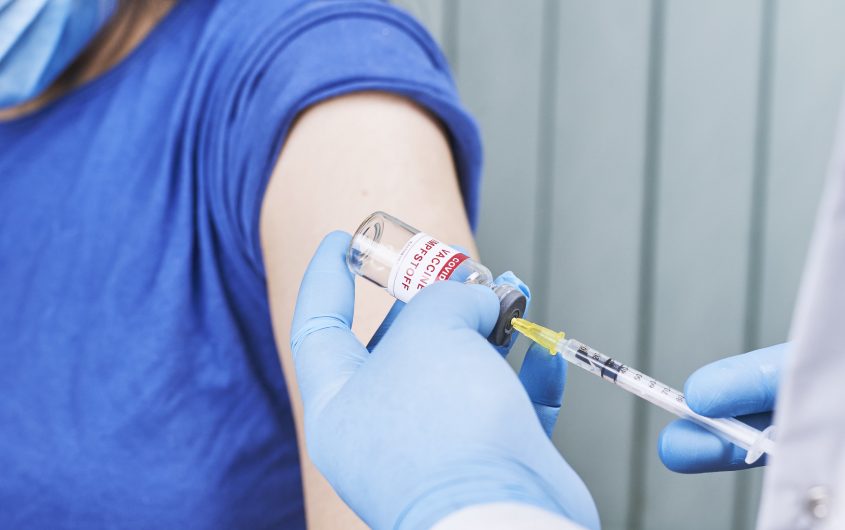
Tim Reckmann via Flickr
The German Approach to the COVID-19 Pandemic

Johanna Siegert
University of Fulda
Johanna Siegert completed her B.A. in Social Science at the University of Siegen in 2021. In her studies, she has focused on the challenges of governance of migration and integration politics, poverty, social inequality and inter-state conflicts. Additionally, she received a certificate in gender studies. For her bachelor’s thesis, she concentrated on the issue of domestic violence against women, particularly interested in the question of why it’s not possible practically or emotionally for women to leave abusive relationships. Johanna Siegert currently studies in a Master’s in Human Rights Studies in Politics, Law and Society at the University of Fulda.

Sophie Stützle
University of Bremen
Sophie Stützle is working towards a multidisciplinary bachelor’s degree in Public Health/Health Science at the University of Bremen since 2019. Before she began her degree, she completed a 6-week internship in a general practitioner’s office, where she gained practical experience in health practice. She also studied for 10 months in the U.S. in Wisconsin, which gave her an interest in understanding the mechanisms and practices behind bilateral relations.
Failure or Success?
As we are heading into the third year of the COVID-19 pandemic, we must admit that the Coronavirus remains a sticky challenge—locally and globally. As of the beginning of March 2022, Germany is reporting a seven-day incidence rate of 1439. By the time you are reading this article, the number most likely will have increased. Almost 400 million people have been infected worldwide thus far. It is a good time to take a deeper, critical look at different approaches to the fight against the COVID-19 pandemic in Germany and beyond and to ask: What can we learn today that will prepare us for tomorrow? What can we learn by looking across borders?
Over the past two years, countries within the European Union (EU) have continuously found themselves in the position of becoming COVID epicenters. They differ widely in terms of public health measures, such as vaccination rates, monitoring, testing capacities, and generally the implementation of “non-pharmaceutical-interventions,” such as mandates for wearing masks. Vaccination rates range from 89.4 percent and 80.9 percent in the western European countries Portugal and Spain to 41.4 percent and 29 percent in the eastern European countries of Romania and Bulgaria. With a population of nearly 75 percent fully vaccinated citizens, the vaccination rate in Germany certainly is not at a rate where both health experts and the government want it to be. The explanation for such low vaccination rates turns out to be quite complex.
A challenging context for the German vaccination campaign
The German vaccination campaign has been rattled by a scene of anti-vaccinationists and conspiracists, which has been fueled by insufficient communication on the part of the government. What characterizes these groups is a disbelief in science as well as skepticism towards the media and politics. The right-wing populist rally party Alternative für Deutschland (AfD) is considered the mouthpiece of the general protest. The party aggravates voters against refugees, climate change, and, more recently, the government’s COVID measures, including its vaccination campaigns. What adds to this is the socio-economic decline east German states such as Saxony, Saxony-Anhalt, and Thuringia have experienced over the past thirty years. It has caused mistrust towards the government among parts of the population. This mistrust already came to light in 2015 during the “refugee crisis.” It is in these parts of Germany that COVID-incidences and AfD vote shares correlate in a striking way.
The countries with higher vaccination rates mainly show a higher level of trust in measures implemented by the government. Distrust in the government poses obstacles to COVID responses.
Another crucial driver of protest towards Germany’s vaccination campaign is highly unique to Germany and lies within its “paramedical milieu.” Based on the Alternative Medical Practitioners Act of 1939 and the success story of the anthroposophic movement, “Healers” and other non-medical practitioners without a formal university degree are widespread phenomena, especially in the Southern and Western parts of Germany. Next to the right-wing movement, they form the core of the protest movement in Germany.
The ups and downs in the German approach
Germany weathered the first wave of infections quite well. Hospitals showed sufficient capacities. The public largely observed the requirement to wear masks. However, this positive outlook changed somewhat over time and new challenges came to light: One major aspect was the lack of digitalization. Germany’s digitalization, as well as secure data exchange, remains widely underdeveloped compared to other EU countries. Nursing staff at hospitals and public health offices had to witness this first-hand; resources were insufficient, there was a shortage of staff, and the bureaucracy of account tracking of corona cases even ran on paper at the beginning. Germany had been cutting corners in public health services for decades. As a result, a delay of fourteen days in contacting people who tested positive was not uncommon. Germany further missed out on involving its military more efficiently. Usually responsible for external defense, the German “Bundeswehr” can offer domestic administrative assistance in times of national crises. But this potential was only sparsely tapped with politicians arguing the Bundeswehr should stay focused on external security and communities skeptical of having the military present in their local activities. In contrast, Germany fared well throughout the pandemic by including scientists in political decision-making. The government took close advice from the Robert Koch Institute, its medical advisory body, as well as from virologists, and it consulted studies and research results from other countries, such as England and Israel. In terms of some of its public health measures, Germany was even quite the pioneer compared to its neighboring countries. This is true for its “3G” (“vaccinated, recovered, tested”) regulation for public life, such as restaurants, cultural venues, and other gathering places. However, this rule was introduced into the workplace rather late compared to neighboring countries, but it still represented a drastic stepping stone for Germany in enabling the workforce to return to their offices.
In terms of compulsory vaccinations, Germany is, once again, not at the forefront compared to its European neighbors. Compulsory vaccination for health personnel came into force in Italy as early as May 2021; France followed in September 2021, Austria in February 2022, and Germany is scheduled to follow in March 2022. However, German federal and state-level politicians are now challenging the corresponding law, arguing for instance that it is impossible to implement without risking a breakdown in the healthcare system, thereby creating uncertainty among the public.
The key to better preparedness will be to invest in better research.
Finally, timing has not been a friend to the German pandemic approach, especially in this current fourth wave. The general election campaign in the fall of 2021 stalled the fight against rapidly rising COVID incidences tremendously. Vigorous calls for action by many scientists were left unheard while Germany was searching for its next chancellor. Politicians did not want to make themselves unpopular by advocating strict pandemic strategies in their election platforms. A study by Ludwig-Maximilians University in Munich showed that only between 1.2 percent to 14 percent of the candidates’ social media posts included references to the coronavirus. Thus, the election campaign caused Germany a great loss of time, structure, and organization during defining turning points when countries like France and Israel had already started with booster vaccination campaigns to combat their Omicron waves.
A peek across the Atlantic
The German approach highlights that the fight against the pandemic unfortunately is not a sprint but a bumpy marathon. Looking across the Atlantic, we see that the United States has faced its own obstacles in trying to fight this intricate virus. Throughout the pandemic, many challenges arose, including the questionable political leadership of Donald Trump; different approaches at the state level; the privatized health sector and lack of universal healthcare; and the disagreements between Democrats and Republicans resulting in the politicization of the pandemic. The result: A low vaccination rate of 63 percent. In both the United States and Germany, the pandemic has mercilessly exposed weaknesses that existed prior to the crisis. Though even this tedious marathon shall demand a final sprint to cross the finish line one of these days.
Based on the points discussed above, we can gather that both Germany and the United States could have had a much better outcome in fighting the pandemic. The countries with higher vaccination rates mainly show a higher level of trust in measures implemented by the government. Distrust in the government poses obstacles to COVID responses, as Germany and the Unites States demonstrate. And while this problem is difficult to address, there are some lessons learned from successful countries that could prepare Germany and the United States better for the future. One example is a vaccination campaign that touches the emotions of the population. While in France, for instance, the campaigns were based on pictures of couples kissing each other in clubs, Germany went with a less scandalous approach: Slogans like “sleeves up” and “vaccination helps”. Another example is an automated vaccination appointment system, as implemented in Spain, making it more convenient for people to receive their vaccination, than to schedule an appointment themselves. A third example is more military involvement to help with contact tracing, supplying the population with masks and hygiene products. Another lesson for Germany in particular is the need to expand the existing data infrastructure and to expedite digitalization to allow for easier data exchange and tracking. Finally, the key to better preparedness will be to invest in better research.
By reflecting on the many lessons learned throughout the past years, we will be prepared for tomorrow.








